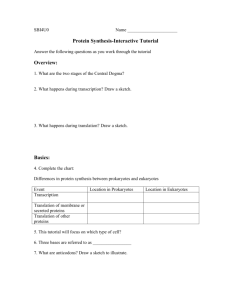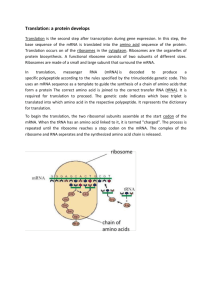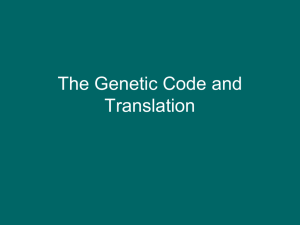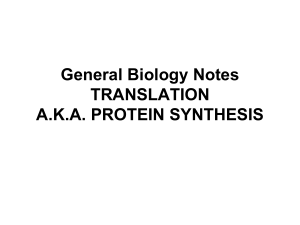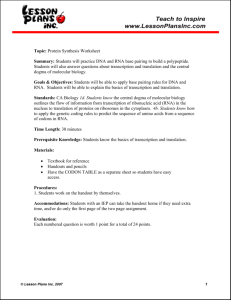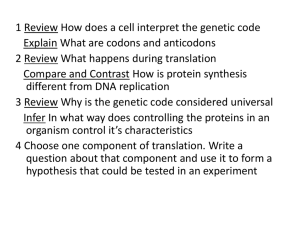Translation 2015
advertisement
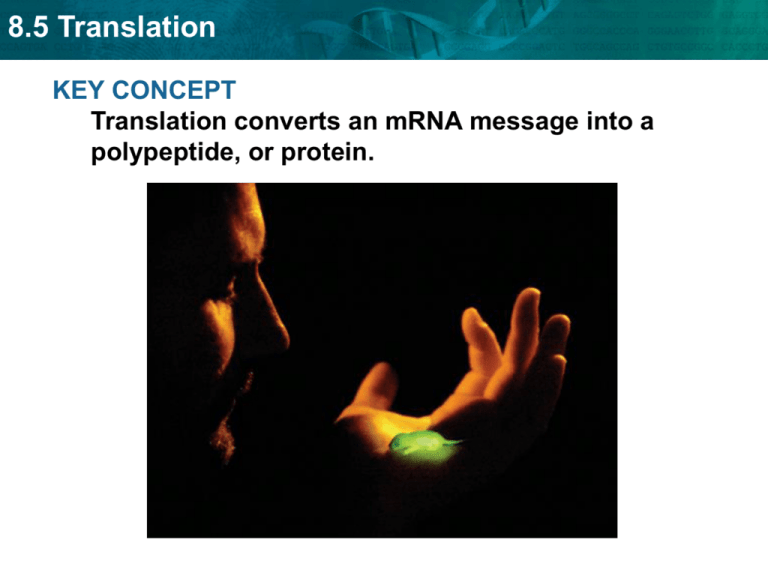
8.5 Translation KEY CONCEPT Translation converts an mRNA message into a polypeptide, or protein. 8.5 Translation Amino acids (protein building blocks) are coded for by mRNA base sequences. • A codon is a sequence of three nucleotides that codes for an amino acid. codon for methionine (Met) codon for leucine (Leu) 8.5 Translation • The genetic code matches each codon to its amino acid or function. The genetic code matches each RNA codon with its amino acid or function. – three stop codons signal the end of a chain of amino acids. – one start codon, codes for methionine and to start translation 8.5 Translation • Reading frame: multiple codons that code for a chain of amino acids • A change in the order in which codons are read changes the resulting protein – this is why having a clear “start” and “stop” is important • Common (universal) language: Regardless of the organism, codons code for the same amino acid. 8.5 Translation Amino acids are linked to become a protein. • An anticodon is a set of three nucleotides that is complementary to an mRNA codon. • An anticodon is carried by a tRNA. tRNA carries amino acids from cytoplasm to the ribosome to become part of the growing protein. EXAMPLE: mRNA codon=GUU tRNA anticodon=CAA Amino acid=Valine 8.5 Translation • Ribosomes are the site of protein synthesis. They are located in the cytoplasm & on the rough ER. • Ribosomes are made of rRNA & proteins. They have a large & small subunit. • Helps form peptide bonds between amino acids. 8.5 Translation 1. For translation to begin, tRNA binds to a start codon (Met in picture) and signals the ribosome to assemble. – A complementary tRNA molecule binds to the exposed codon (Leu in picture), bringing its amino acid close to the first amino acid. 8.5 Translation 2. The ribosome helps form a polypeptide bond between the amino acids. The ribosome pulls the mRNA strand the length of one codon. 8.5 Translation 3. The now empty tRNA molecule exits the ribosome. – A complementary tRNA molecule binds to the next exposed codon. – Once the stop codon is reached, the ribosome releases the protein and disassembles. 8.5 Translation 8.5 Translation 8.5 Translation Describe how the processes of transcription and translation are similar in all organisms. Both prokaryotes and eukaryotes have DNA and follow the same base pairing rules, so they both can change DNA into RNA. The big difference here is that Eukaryotes carry out transcription in the nucleus, prokaryotes carry it out in the cytoplasm because they have NO nucleus. Translation occurs at the site of a ribosome. Since both cell types have ribosomes, ALL living things go through translation aka protein synthesis. • https://www.youtube.com/watch?v=K2_uB7ybfYM
